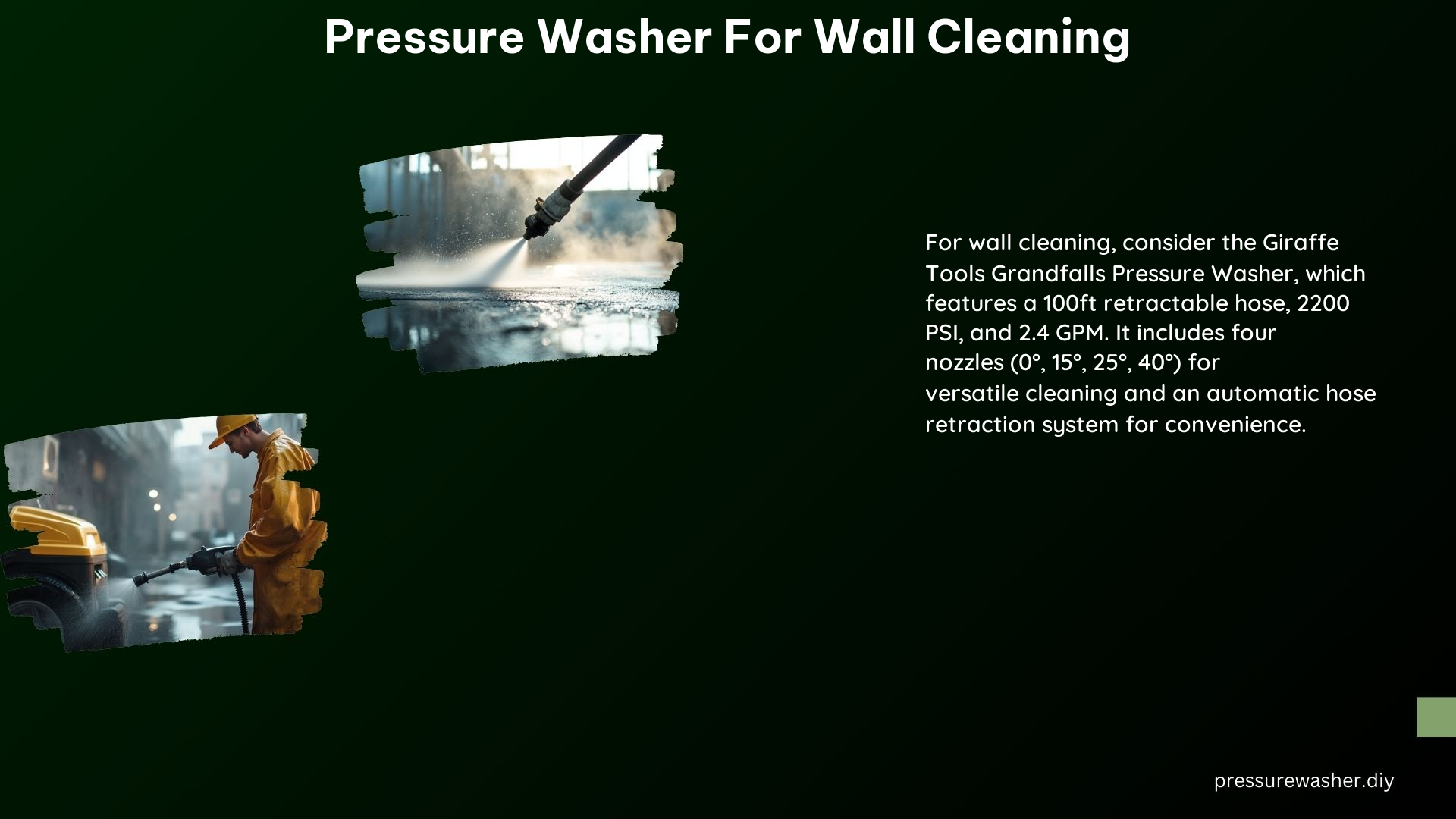When it comes to effectively cleaning walls, a pressure washer can be a game-changer, providing the power and precision needed to tackle even the toughest grime and stains. Whether you’re dealing with mildew, dirt, or stubborn buildup, the right pressure washer can make the job a breeze. In this comprehensive guide, we’ll dive deep into the key factors to consider when selecting the perfect pressure washer for your wall cleaning needs.
Pressure (PSI) and Flow Rate (GPM)
The pressure (measured in Pounds per Square Inch, or PSI) and flow rate (measured in Gallons per Minute, or GPM) of a pressure washer are crucial factors in determining its effectiveness for wall cleaning. Generally, a PSI range of 1,500 to 2,000 is suitable for general wall cleaning tasks, while a higher PSI of 2,500 to 3,000 may be necessary for more stubborn dirt or stains.
It’s important to note that the ideal PSI and GPM can vary depending on the type of wall material and the level of soiling. Softer surfaces, such as vinyl or wood, may require a lower PSI to avoid damage, while harder surfaces like concrete or brick can handle higher pressures. As a rule of thumb, start with a lower PSI and gradually increase it until you achieve the desired cleaning results without causing any surface damage.
Nozzle Selection

The type of nozzle you use can significantly impact the efficiency and effectiveness of your wall cleaning efforts. For general wall cleaning, a wide-angle fan tip (25° or 40°) is recommended, as it provides a broader cleaning area and reduces the risk of damaging the surface. These nozzles are ideal for covering larger surface areas quickly and evenly.
However, for more focused cleaning tasks, such as removing stubborn stains or grime, a narrower nozzle (0° or 15°) may be more suitable. These concentrated nozzles allow you to target specific problem areas with greater precision, but they should be used with caution to avoid surface damage.
When selecting a nozzle, consider the size of the area you need to clean, the type of dirt or stains you’re dealing with, and the sensitivity of the wall material. Experiment with different nozzle angles and distances to find the optimal balance between cleaning power and surface protection.
Hose Length and Retraction
The length of the pressure washer’s hose can be a crucial factor, especially when cleaning larger walls or areas that are difficult to access. A longer hose, typically 100 feet or more, can provide greater flexibility and allow you to cover more ground without constantly moving the pressure washer unit.
Additionally, pressure washers with automatic hose retraction systems can make the cleaning process more efficient and convenient. These systems allow you to easily manage the hose, reducing the risk of tangles or tripping hazards, and saving valuable storage space when the pressure washer is not in use.
Motor Type and Power
When it comes to pressure washers for wall cleaning, electric models are generally more suitable for home use due to their ease of use and lower noise levels. Look for pressure washers with induction motors, as they tend to be more efficient and have longer lifespans compared to universal motors.
The power output of the motor, measured in horsepower (HP) or watts, can also impact the cleaning performance. Higher-powered motors can generate more pressure and flow rate, making them better equipped to handle tougher cleaning tasks. However, it’s important to balance power with maneuverability and ease of use, especially if you’ll be working in confined spaces or on delicate wall surfaces.
Additional Features
Beyond the core specifications, consider pressure washers with additional features that can enhance the wall cleaning experience. Some useful features to look for include:
- Total Stop System (TSS): This feature automatically shuts off the pump when the trigger is released, saving energy and prolonging the pump’s lifespan.
- Wall-Mounted Design: Pressure washers with wall-mounted designs can save valuable floor space and make the cleaning process more convenient, especially in smaller work areas.
- Automatic Hose Organization: Some pressure washers come equipped with built-in hose management systems, such as retractable or self-winding mechanisms, to keep the hose tidy and organized.
- Adjustable Wands: Telescoping or adjustable wands can provide greater reach and flexibility when cleaning walls, allowing you to access hard-to-reach areas with ease.
- Detergent Tanks: Integrated detergent tanks or injection systems can simplify the application of cleaning solutions, enhancing the overall effectiveness of your wall cleaning efforts.
By considering these additional features, you can find a pressure washer that not only delivers powerful cleaning performance but also offers enhanced convenience and versatility for your wall cleaning needs.
Popular Pressure Washer Models for Wall Cleaning
Here are two popular pressure washer models that are well-suited for wall cleaning tasks:
Giraffe Tools Grandfalls Pressure Washer
- Max Pressure: 2,500 PSI
- Max Flow Rate: 2.4 GPM
- Hose Length: 100 feet
- Motor Type: Induction Motor
- Noise Level: 78-80 dB
- Weight: Not specified
- Dimensions: Not specified
This pressure washer from Giraffe Tools offers a powerful 2,500 PSI cleaning performance, making it suitable for a wide range of wall cleaning tasks. The 100-foot retractable hose provides excellent coverage, while the all-in-one design ensures easy use and convenient storage.
Powerhorse Pressure Washer Wall Cleaner
- Max Pressure: 3,000 PSI
- Max Flow Rate: Not specified
- Hose Length: Not specified
- Motor Type: Not specified
- Noise Level: Not specified
- Weight: Not specified
- Dimensions: Not specified
The Powerhorse Pressure Washer Wall Cleaner is designed specifically for wall cleaning applications, with a maximum pressure of 3,000 PSI. This model works with telescoping wands, allowing you to reach and clean walls with greater ease and precision, making it a suitable choice for more heavy-duty wall cleaning tasks.
Remember, when selecting a pressure washer for wall cleaning, it’s essential to consider the specific needs of your project, the type of wall material, and the level of dirt or grime you’re dealing with. By carefully evaluating the key factors and features, you can find the perfect pressure washer to tackle your wall cleaning challenges with efficiency and ease.
